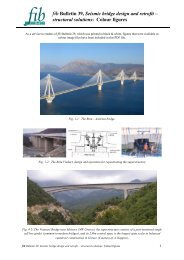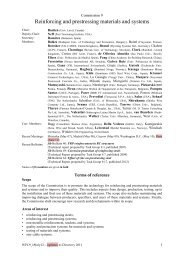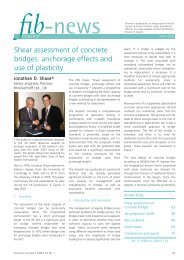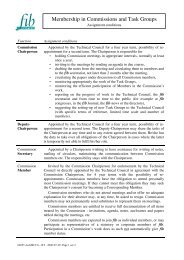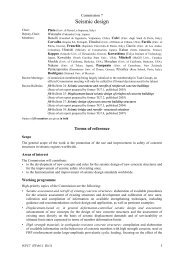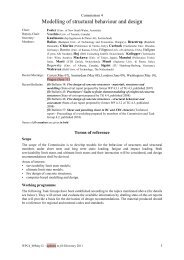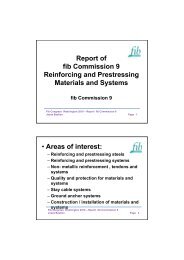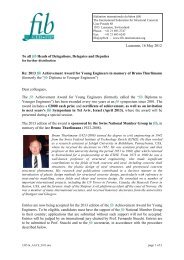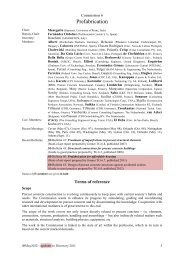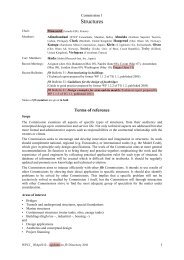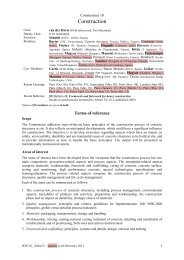The International Federation for Structural Concrete
The International Federation for Structural Concrete
The International Federation for Structural Concrete
You also want an ePaper? Increase the reach of your titles
YUMPU automatically turns print PDFs into web optimized ePapers that Google loves.
Task Group<br />
TG 8.8 <strong>Structural</strong> design with flowable concrete<br />
Conveners: Grünewald (TU Delft, <strong>The</strong> Netherlands), Ferrara (Politecnico di Milano, Italy)<br />
Members:<br />
(tentative)<br />
Barragan (BASF, Italy), Barros (Univ. of Minho, Portugal), Behloul (Lafarge, France), Beitzel<br />
(IBU Trier, Germany), Billberg (CBI Stockholm, Sweden), Dehn (MPFA Leipzig, Germany),<br />
Den Uijl (TU Delft, <strong>The</strong> Netherlands), Di Prisco (Politecnico di Milano, Italy), Domone<br />
(Univ. College London, UK), Freytag (TU Graz, Austria), Geiker (DTU Lyngby, Denmark),<br />
Gettu (Indian Institute of Technology Madras, India), Hammer (Sintef, Norway), Kanstad<br />
(NTNU, Norway), Laranjeira (UP Catalunya, Spain), Martinie (LCPC, France), Obladen<br />
(Strukton, <strong>The</strong> Netherlands), Roussel (LCPC, France), Sato (Hakkaido Univ., Japan), Schmidt<br />
(BAM, Germany), Sonebi (Queen's Univ. Belfast, UK), Stähli (Concretum Zürich, Switzerland),<br />
Stang (DTU Lyngby, Denmark), Vandewalle (Katholieke Universiteit Leuven, Belgium),<br />
Walraven (TU Delft, <strong>The</strong> Netherlands), Zilch (Techn. Univ. München, Germany)<br />
Recent Meetings: Ghent (April 09), Milan (Jan. 10), Montreal (Sept. 10)<br />
Names of fib members are given in bold<br />
Terms of reference<br />
Scope<br />
Flowable concretes (self-compacting or highly flowable) have evolved to a commonly applied<br />
building material. In spite of significant experience with flowable concrete problems still occur during<br />
casting and the service life of concrete structures. <strong>The</strong> flow (initiated by vibration and/or the weight of<br />
concrete) can affect the structural behaviour of hardening or hardened concrete. In order to obtain a<br />
high flowability the mixture composition has to be adjusted and optimised. <strong>The</strong> effect of fibres on the<br />
characteristics of flowable concrete will be considered in a subgroup of fib TG 8.8.<br />
<strong>The</strong> main objectives of fib Task Group 8.8 are to write a state-of-the-art report and a recommendation<br />
on the structural design with flowable concretes. <strong>The</strong> per<strong>for</strong>mance of a structure with flowable<br />
concrete depends not only on material characteristics, but also on the production method and the<br />
structure itself. Areas of structural design where flowable concretes differ from traditional vibrated<br />
concrete have to be identified. Four aspects will be considered in order to describe structural<br />
behaviour:<br />
- mechanical characteristics<br />
- local effects (i.e. close to the concrete surface or rein<strong>for</strong>cement bars)<br />
- effects of orientation/segregation due to the flow/vibration<br />
- how to optimise the mixture composition of and production techniques <strong>for</strong> flowable concrete<br />
Working programme<br />
fib TG 8.8 consists of two subgroups: 'plain concrete' and 'fibre rein<strong>for</strong>ced concrete'; both groups meet<br />
together. <strong>The</strong> second group will focus on the effect of orientation and distribution of fibres on the<br />
characteristics of flowable concrete, whereas other relevant aspects will be considered by the first<br />
group. <strong>The</strong> work is divided in three phases: 1) orientation, 2) compilation and comparison (output:<br />
state-of-art report) and 3) translation (output: recommendation).<br />
WPC8_22Nov12 – updates to fib Directory 2011 4



